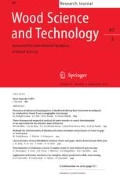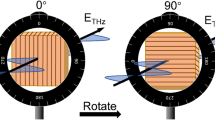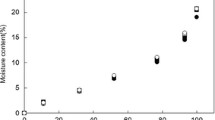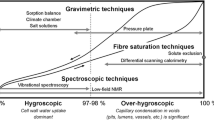Abstract
The aim of this study is to determine the dielectric constant of woody biomass at different water contents and describe its behavior with a dielectric mixing model. The use of the model for determination of water content is also verified. Dielectric constants were calculated from the travel times of electromagnetic waves with a center frequency of 555 MHz through collected biomass samples. The power law, Maxwell–Garnett, and Polder van Santen mixing models were applied to the experimental data. In the models, biomass was considered as a mixture of three phases: a solid solution composed of wood cellular material and bound water, free water, and air. The experimental data was found to be better described by the Maxwell–Garnett model. The use of this model along with an independent validation set for the determination of volumetric water content resulted in a root mean square error of prediction of 0.03 within the investigated volumetric water content range of 0.07–0.29.




Similar content being viewed by others
References
Berry S, Roderick M (2005) Plant-water relations and the fibre saturation point. New Phytol 168(1):25–37
Dirksen C, Dasberg S (1993) Improved calibration of time domain reflectometry soil water content measurements. Soil Sci Soc Am J 57(3):660–667
Ferre P, Topp G (2000) Time-domain reflectometry techniques for soil water content and electrical conductivity measurements. In: Baltes H, Göpel W, Hesse J (eds) Sensors update. Wiley-VCH, New York, pp 277–300
Hallikainen M, Ulaby F, Aderlrazik M (1984) The dielectric behaviour of snow in the 3 to 37 GHz range. In: IGARSS ‘84. Remote sensing—from research towards operational use. Strasbourg, pp 169–174
Heimovaara T, Bouten W, Verstraten J (1994) Frequency domain analysis of time domain reflectometry waveforms. 2. A four-component complex dielectric mixing model for soils. Water Resour Res 30(2):201–210
Hendriks A, Zeeman G (2009) Pretreatments to enhance the digestibility of lignocellulosic biomass. Bioresour Technol 100(1):10–19
Jones S, Or D (2003) Modeled effects on permittivity measurements of water content in high surface area porous media. Physica B Condens Matter 338(1-4):284–290
Koponen S (2005) The consequences of wood cellular structure and rolling-shear in crossbanded veneer composites. PhD thesis, Helsinki University of Technology
Kupfer K (2005) Electromagnetic aquametry. Wiley, New York
Mironov V, Dobson M, Kaupp V, Komarov S, Kleshchenko V (2004) Generalized refractive mixing dielectric model for moist soils. IEEE Trans Geosci Remote Sens 42(4):773–785
Nelson S (2006) Agricultural applications of dielectric measurements. IEEE Trans Dielectr Electr Insul 13(4):688–702
Nyfors E, Vainikainen P (1994) Industrial microwave sensors. Artech House
Nyström J (2006) Rapid measurements of the moisture content in biofuel. PhD thesis, Mälardalen University
Nyström J, Dahlquist E (2004) Methods for determination of moisture content in woodchips for power plants - a review. Fuel 83(7-8):773–779
Nyström J, Thorin E, Backa O, Dahlquist E (2005) Moisture content measurements on sawdust with radio frequency spectroscopy. In: Proceedings of the ASME power conference. Chicago, pp 697–702
Paz A, Nyström J, Thorin E (2006) Influence of temperature in radio frequency measurements of moisture content in biofuel. In: Proceedings of the IEEE instrumentation and measurement technology conference, Sorrento, Italy
Robinson D, Jones S, Wraith J, Or D, Friedman S (2003) A review of advances in dielectric and electrical conductivity measurement in soils using time domain reflectometry. Vadose Zone J 2(4):444–475
Sihvola A (1999) Electromagnetic mixing formulas and applications. The Institution of Electrical Engineers
Sihvola A, Kong J (1988) Effective permittivity of dielectric mixtures. IEEE Trans Geosci Remote Sens 26(4):420–429
Skaar C (1988) Wood-water relations. Springer-Verlag, New York
Sugiyama M, Norimoto M (2003) Dielectric properties of chemically treated wood. J Mater Sci 38(22):4551–4557
Sun Z (2008) Estimating volume fraction of bound water in portland cement concrete during hydration based on dielectric constant measurement. Mag Concrete Res 60(3):205–210
Topp G, Davis J, Annan A (1980) Electromagnetic determination of soil water content: measurements in coaxial transmission lines. Water Resour Res 16(3):574–582
Topp G, Zegelin S, White I (2000) Impacts of the real and imaginary components of relative permittivity on time domain reflectometry measurements in soils. Soil Sci Soc Am J 64(4):1244–1252
Torgovnikov G (1992) Dielectric properties of wood and wood based materials. Springer-Verlag, New York
Turesson A (2006) Water content and porosity estimated from ground-penetrating radar and resistivity. J Appl Geophys 58(2):99–111
Ulaby F (2007) Fundamentals of applied electromagnetics, 5th edn. Pearson Prentice Hall
Vallone M, Cataldo A, Tarricone L (2007) Water content estimation in granular materials by time domain reflectometry: A key-note on agro-food applications. In: IEEE Instrumentation and Measurement Technology Conference, Warsaw, Poland
van Dam R, Borchers B, Hendrickx J (2005) Methods for prediction of soil dielectric properties: a review. In: Proceedings of the SPIE—the international society for optical engineering. Orlando, pp 188–197
Acknowledgments
The authors would like to thank Värmeforsk—the Swedish district heating association, for financing the project in which this study is included and the combined heat and power plants Mälarenegi in Västerå s and Eskilstuna Energi och Miljö in Eskisltuna, Sweden, for providing the biofuel samples used in this study.
Author information
Authors and Affiliations
Corresponding author
Rights and permissions
About this article
Cite this article
Paz, A., Thorin, E. & Topp, C. Dielectric mixing models for water content determination in woody biomass. Wood Sci Technol 45, 249–259 (2011). https://doi.org/10.1007/s00226-010-0316-8
Received:
Published:
Issue Date:
DOI: https://doi.org/10.1007/s00226-010-0316-8




